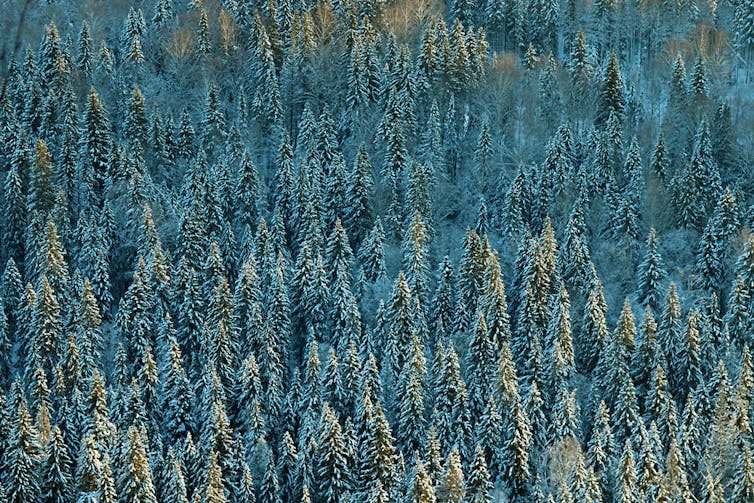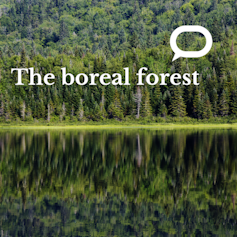In Québec, there are two distinct types of forest: the northern temperate forest in the south, and the boreal forest in the north.
These forest ecosystems provide many different and essential services to the overall functioning of the planet, and to our economy. For example, the storage of large quantities of atmospheric carbon and habitats for many species, as well as a supply of raw materials to the wood industry, which is a pillar of the economies of both Québec and Canada.
This article is part of La Conversation Canada’s series The boreal forest: A thousand secrets, a thousand dangers
La Conversation Canada invites you to take a virtual walk in the heart of the boreal forest. In this series, our experts focus on management and sustainable development issues, natural disturbances, the ecology of terrestrial wildlife and aquatic ecosystems, northern agriculture and the cultural and economic importance of the boreal forest for Indigenous peoples. We hope you have a pleasant — and informative — walk through the forest!
As a doctoral student at Université du Québec en Abitibi-Témiscamingue (UQAT), I work on the colonization potential of sugar maple, yellow birch and red maple north of their range, in the mixed boreal forest. These three emblematic species of North American forests are of capital economic importance (for lumber, manufacture of plywood, pulp, or maple syrup for sugar maple) and contribute to the diversity of Québec’s forests.
The mixed forest, between the temperate and boreal biomes
The mixed forest is located in the transition zone (ecotone) between the boreal and temperate forests.
It refers to the region where these two forests meet, creating an area in which the characteristics of these two types of forest intermingle. This amalgam is characterized by a complex coexistence between temperate hardwood species and the conifers typical of the boreal forest.
It is in this ecotone that temperate hardwoods reach the northern limit of their distribution.
An uncertain future for the mixed boreal forest
The combined impact of rising temperatures (2-8°C by 2100) and forest management in the boreal mixedwood forest could alter the growth and distribution of temperate species. The ecosystem services provided by these species could then be altered.
This transformation could be profound. Temperate hardwood species could migrate northwards and even become dominant species in boreal mixedwood stands.
Such a change in the forest composition of the boreal mixedwood forest could have major consequences for the forest industry, natural disturbance regimes and the biodiversity associated with the dominant tree species in the forests. However, there is still considerable uncertainty surrounding the factors that influence the successful establishment and growth of temperate hardwoods in the boreal mixedwood forest.
In order to get a complete picture of the future of the boreal mixedwood forest, it is essential to understand how the growth and establishment of temperate hardwoods within mixedwood stands is influenced by factors such as climate, soil characteristics and competitive interactions between trees.
Hardwoods in the mixed boreal forest?
As part of my doctoral work, we attempted to model competitive interactions between trees by taking into account the effects of climate change on their growth. This model simulates each tree in a stand. Each year, trees grow, reproduce and eventually die. The growth of each tree depends on the light the tree receives, competition for nutrients and space, and climate.
In our study, published in the journal Ecography, we used this model to evaluate the capacity of temperate deciduous trees to establish themselves within mixed species stands in the boreal forest. To do this, we modelled typical mixed stands of the boreal forest, then integrated temperate deciduous species into these, giving the trees the opportunity to colonize these stands.
We showed that the three species of temperate hardwoods could colonize the stand. Yellow birch had a better colonization capacity, with its more numerous and lighter seeds which can disperse further. Red maple and sugar maple had similar abilities when it came to colonizing boreal mixed stands. However, sugar maple showed a better ability to colonize older forests, due to its superior growth under a closed canopy.

(Shutterstock)
The establishment capacity of temperate hardwoods in the boreal mixed forest was higher in the youngest stands, as well as in stands after clear-cutting. Therefore, forest management and forest fires, by rejuvenating boreal mixed forest landscapes, could accelerate the northward migration of temperate tree species.
Increased temperatures due to climate change are not expected to increase the ability of temperate hardwoods to colonize boreal mixedwood forest stands, either in the current climate or under high climate forcing scenarios. This means that climate would not be a factor influencing the northern limit of distribution of temperate hardwood species, and therefore, that climate change should not have an immediate effect on the northern distribution of temperate hardwoods.
The soil types of the boreal mixed forest could, however, be a limit to the growth of temperate hardwoods. In clay soils, the growth of red maple and sugar maple would be poor and would not allow them to be competitive with the species already present, which tolerate clay very well.
Factors governing tree growth such as climate, soil and competition interact together and can make predictions about the future distribution of different tree species very complex.
Both positive and negative effects
The establishment of temperate hardwoods in the boreal mixed forest could increase the complexity and diversity in stands. This could strengthen the resistance and resilience of the boreal mixed forest to disturbances.
The presence of temperate deciduous trees in mixed boreal forests could, in particular, attenuate spruce budworm epidemics, because the proportion of fir and spruce trees would be lower and these species would be more dispersed in the stands.
The establishment of temperate deciduous trees will cause an increase in the proportion of deciduous trees in the landscape. This phenomenon, known as enfoliation, has been observed in the mixed boreal forest for the last 100 years and is mainly due to forest management. This envelopment could make epidemics of forest livery more severe. This defoliating insect attacks deciduous trees and especially aspen, paper birch and sugar maple.
Finally, wildfire regimes could be modified by the differences in flammability of hardwoods and conifers. The presence of temperate deciduous trees, which are less flammable than conifers, could lengthen fire cycles. This positive effect will, however, be associated with a major challenge for the forestry industry which manages the mixed boreal forest, since the industry is currently focused mainly on conifers.
We can’t stop there
Further modelling studies are needed to explore the impact of other factors that may influence the ability of temperate hardwoods to colonize boreal mixedwood forest.
In particular, we can think of the impact of soil and mycorrhizae (symbiosis between the roots of plants and fungi) on the germination and growth of trees, but also the effect of weather phenomena, such as late frosts, which can affect the survival and growth of young temperate trees.
Additionally, landscape scale modeling would be beneficial in order to be able to consider the topography of the land, a potentially influential factor on the ability of temperate hardwoods to establish further north.




